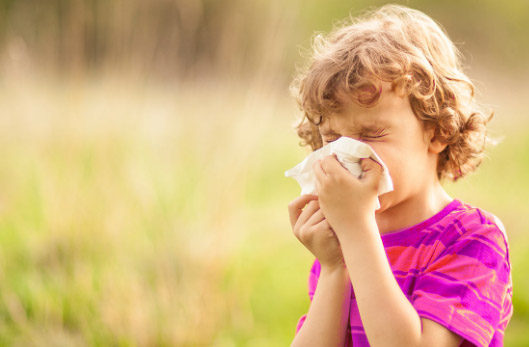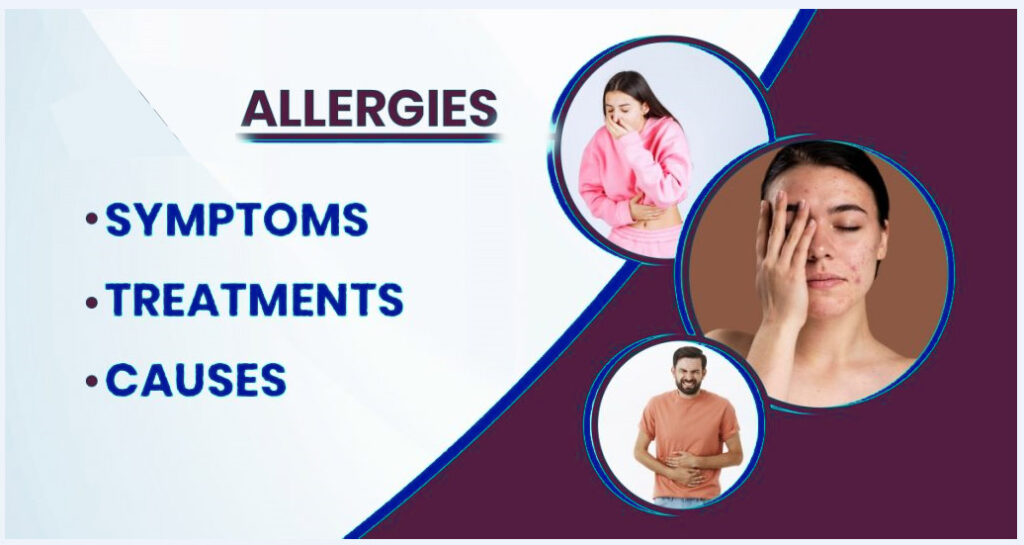Environmental allergies are on the rise. What are the dangers, and what can you do to protect your child?
Arunny nose, a wheezy chest, rashes, itchy eyes – these are just some of the symptoms of allergies. Even a mild allergy can be unpleasant; a severe allergy can be life-threatening.
Allergies are on the rise. UK stats tell us that one in five pre-schoolers has eczema, and one in seven asthma.
Read : Asthma Adult Definition, Causes, Symptoms
The incidence of these two and other allergy-related conditions is increasing, says allergy specialist Dr Adrian Morris of The Allergy Clinic in Cape Town: “We believe that it’s because children don’t get exposed to as many germs as they used to, because they have fewer siblings and cleaner homes. The immune system has nothing to focus on, so it focuses on things that are actually harmless – dust or cats, for example. In farming communities, people have fewer allergies.”
Read : Allergic Rhinitis, Causes, Symptoms, Complications
With allergies, it is all about being prepared and knowing how to respond appropriately. Severe allergic reactions can be scary, but with the right approach and medications on hand, allergies can be better managed and, in some cases, avoided, according to Best Care, a first aid series by Bestmed Medical Scheme.
WHAT IS AN ALLERGY?
An allergy is a negative immune system response. Your immune system identifies a particular substance (the allergen) as harmful and launches an immune response, producing an antibody called immunoglobulin E (IgE).
Read : Food Allergy, Causes, Symptoms, Complications and Cost in India
This overreaction of the immune system includes the release of various chemicals (including histamines) that produce the swelling, itching and other symptoms that we associate with allergies.
In the case of an extreme response, breathing is affected.
Allergic reactions can be triggered by something your child eats or inhales, or something that irritates the skin. Insect stings can also cause an allergic reaction.
Read : Insect Allergy, Causes, Symptoms, Complications and Cost in India
IS IT AN ALLERGIC REACTION?
Gauteng-based paediatrician Dr Kevanya Coopoo, says that allergies can make themselves known all over the body. “The skin is a good place to check first. Does your child have a rash, swelling or welts? You can also consider the chest – are they struggling to breathe, breathing faster than usual or unable to speak? All of these are markers of an allergic reaction.” When it comes to treating an allergic reaction, prevention is always better than cure. For a child with unpreventable allergies, introducing allergens early ensures that you’re able to identify high risk foods early on and better manage your child’s health going forward.
Read : Best Cost Allergy Testing Surgery, Treatment Hospital in India
“The most dangerous side effect is anaphylaxis, an acute allergic reaction where the body becomes hypersensitive. You’ll know this is the case when your child appears pale, collapses or feels dizzy. In the case of anaphylaxis, it’s important that your child is rushed to hospital immediately,” she advises.
WILL YOUR BABY BE AFFECTED?
There’s a strong genetic component to allergies. Allergy specialist Dr Morris says that if one parent has allergies, the chance of the child having allergies is 30 percent; if both parents are allergic, it is 60 percent. If both parents have the same allergy, the chance of their child having it is almost 80 percent.
Read : Allergic Bronchopulmonary Aspergillosis (ABPA)
WILL HE OUTGROW IT?
Roughly 50 percent of kids outgrow their allergies by their teenage years. Sometimes, the allergic condition changes. Dr Morris calls it “the allergic march”: A baby who has eczema and egg or milk allergies may outgrow the eczema by 2 years, and then develop asthma in early childhood. This will improve, and the child will develop hay fever as an adolescent. In the mid 20s, the hay fever will settle down. It may also happen that a child grows out of asthma, only to have it reappear at 40 years of age.
WHAT ARE THE COMMON ENVIRONMENTAL ALLERGENS?
■ Dust, dust mites, mould and pet dander
■ Grass and tree pollen
■ Preservatives, food colouring and medication.
IS IT WORTH TESTING FOR ALLERGIES?
It all depends on how bad the symptoms are. Dr Morris advises the testing of asthma sufferers.
He says, “It’s definitely worthwhile to see if it is dust mites, cats or food that triggers the asthma. I would also advise testing if the patient has severe eczema. In small babies with eczema, you often find an egg, cow milk or peanut allergy. ” The most common and effective tests are the RAST test (a blood test) and the skin prick test. Dr Morris: “The accuracy is about 80 percent. A slight positive is not very helpful, but a strong positive reaction is. There are a lot of other tests around, some of them very expensive, and some of them ‘alternative’, but I would not recommend them.”
COPING WITH HAY FEVER
Does your child seem to have a permanently runny nose? It could be “seasonal allergic rhino-conjunctivitis”, commonly known as hay fever, which affects 20 percent of the general population and up to 50 percent of adolescents. Symptoms include itchy nose, ears and throat; runny nose; sneezing; headaches and facial pain; and even wheezing. In severe cases, hay fever can affect daily life adversely and even disturb sleep. Children who have allergic rhinitis are at greater risk of having asthma or eczema, and may also be more prone to upper respiratory, sinus, or ear infections.
Read : Six Ways To Cope With Arthritis During Pregnancy

If these symptoms are familiar and you think your child has hay fever, how do you know what your child is allergic to? And how can you avoid the allergens? Consider the pattern of your child’s symptoms. If the rhinitis is year-round, the cause is most likely dust, dust mites, mould or domestic pets. If it’s worse at night, bedding and dust mites might be responsible. Here are some tips:
■ Keep pets out of bedrooms.
■ Use “allergy-proof” mattress covers.
■ Use synthetic, allergy-proof pillows rather than feather pillows.
■ Keep stuffed toys off the bed.
■ Vacuum your floors and furniture regularly with an appliance containing aHEPAfilter.
■ Consider a bare floor instead of carpets. If the hay fever is seasonal, occurring at the same time every year, your child is probably allergic to the pollen of particular grass, flowers or trees. It’s next to impossible to avoid these allergens altogether, but the following tips might help:
■ Keep windows and doors closed when pollen counts are high and when the lawn is being mown.
■ Windy conditions exacerbate the problem by spreading pollen – consider staying indoors.
■ Give your child a bath or shower to wash off pollen and change his clothes when he’s been playing outside.
■ Saline nasal sprays may help dislodge pollen from the nose.
Allergic rhinitis can be treated quite successfully. Medical treatment includes antihistamines (there are long-lasting, nonsedating ones available for long term use. Some are available over the counter); nose and eye drops; low dose nasal steroids and decongestants (these reduce inflammation and blockage, but are only suitable for short-term use).
It is best to consult your doctor to get a treatment plan best suited to your child’s age and particular condition.
Read : Vaginal Stretch: Know What Are Its Reasons
DEALING WITH ASTHMA
Asthma, like hay fever, is usually triggered by an allergy to dust mites, grass and tree pollens, birds or pets, and moulds. An allergic response to certain foods can also contribute. Symptoms of asthma are wheezing, a dry irritating cough, tightness of the chest and shortness of breath. These symptoms are caused by the tightening of the muscles around the airway, which results in the inflammation and swelling of the airway. Pollutants in the environment such as cigarette smoke, particular chemicals and car exhaust fumes can trigger an attack. A cold or flu can exacerbate or trigger asthma.
There is no cure for asthma.
The treatment is focused on two aspects – preventing attacks and relieving asthma symptoms when they do occur. Preventative medicines guard against asthma attacks by preventing inflammation and swelling of the mucous membrane in the airway of the lungs. This is a long-term treatment, and the medication must be used every day in order for it to work effectively. Relief medicines relax the muscles surrounding the bronchial tubes, giving relief to patients with breathing difficulty that occurs during an asthma attack. Parents are instinctively wary of medicating children, particularly with strong drugs, but Dr Morris advises against trying to minimise medication: “Use low dose steroid inhalers quickly and early, rather than letting it drag on.” According to recommendations from the Allergy Society of SA, if relievers need to be used frequently, it is an indication that asthma is poorly controlled, and the dosage of preventer treatment might need to be increased, on the advice of your doctor. When asthma is well managed with the right treatment, most asthmatics lead completely normal lives. In most cases, asthmatic children can and do participate fully in sports and exercise.
Read : Sex Positions for Preventing Pregnancy: Is There a “Safe” Approach?
DEALING WITH ECZEMA
Eczema (atopic dermatitis) is a skin condition that has an allergic component to it. Cow’s milk, eggs, wheat, soya protein, peanuts, fish and citrus may contribute to the condition.
Allergy to dust mites or chemicals in skin products and washing powders can cause or exacerbate eczema.
With eczema, your baby develops frequent rashes and red patches. The rash might look like dry, thickened, scaly skin. Sometimes the rash will blister or ooze. It’s uncomfortable and itchy, so babies scratch, sometimes resulting in infection. The face and neck are often affected first, and it may spread to the body, and the inside of the elbows and knees. There are many possible causes for rashes, and young children do have sensitive skin, so it’s a good idea to get a diagnosis from your doctor. Dr Morris advises early treatment. He says, “We used to tell patients to avoid steroid cream. More recent evidence shows that if we treat eczema aggressively when it first occurs, it may go away entirely.” He adds that in the event that eczema suddenly flares up, there may be an infection: “The bacteria staphylococcus is present on the skin of about 80 percent of eczema sufferers, and the patient sometimes develops an allergy to the proteins of the bacteria. If eczema gets suddenly out of control, this may be the cause. Your doctor can take a swab and prescribe an antibiotic if this is the case.” If your child suffers from eczema, the basis of prevention is to take good care of his skin and to avoid dry skin:
■ Wash in lukewarm water and add an emollient. Pat the skin dry. Don’t rub.
■ Use a mild, fragrance-free soap or aqueous cream. Use as little as possible, and always wash at the end of the bath to minimise contact with the skin. Avoid bubble bath and medicated soap.
■ The regular application of emollients moisturises and protects the skin. Dr Morris recommends aqueous cream as a soap substitute but not as an emollient. Instead, he says, use petroleum jelly, Epimax or Cetomacrogol.
■ Dress your baby in cool natural fabrics, such as cotton. Avoid wool, which may scratch and irritate the skin.
■ Use a mild, non-biological washing powder, and rinse laundry well.
■ Keep his nails short, so he doesn’t scratch himself.



